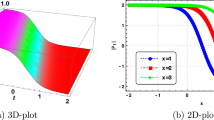Abstract
We construct a center-stable manifold of the ground state solitons in the energy space for the critical wave equation without imposing any symmetry, as the dynamical threshold between scattering and blow-up, and also as a collection of solutions which stay close to the ground states. Up to energy slightly above the ground state, this completes the 9-set classification of the global dynamics in our previous paper (DCDS 33:6, 2013). We can also extend the manifold to arbitrary energy size by adding large radiation. The manifold contains all the solutions scattering to the ground state solitons, and also some of those blowing up in finite time by concentration of the ground states.
Similar content being viewed by others
Notes
The sign of \(\mu \) is switched from [14] for better notational symmetry.
Here for simplicity we use the exponents available only for \(d\le 6\), but it is clear that we only need Hölder continuity of \(f''\), i.e. \(2^*>2\), and so it can be easily modified for all dimensions \(d\ge 3\).
Note that the proof of Lemma 2.2 did not use any particular structure of \({\triangleleft N}(v^\triangleright )\).
The constant \(\iota _I\) is chosen here to be the same as in Lemma 2.2, just for convenience. It does not mean that the admissible range of \(\iota _I\) is exactly the same for these two lemmas.
References
Beceanu, M.: A centre-stable manifold for the energy-critical wave equation in \(\mathbb{R}^3\) in the symmetric setting. arXiv:1212.2285
Bizoń, P., Chmaj, T., Tabor, Z.: On blowup for semilinear wave equations with a focusing nonlinearity. Nonlinearity 17(6), 2187–2201 (2004)
Donninger, R., Huang, M., Krieger, J., Schlag, W.: Exotic blowup solutions for the \(u^5\) focusing wave equation in \(\mathbb{R}^3\). arXiv:1212.4718
Donninger, R., Krieger, J.: Nonscattering solutions and blow up at infinity for the critical wave equation. arXiv:1201.3258v1
Duyckaerts, T., Kenig, C., Merle, F.: Universality of blow-up profile for small radial type II blow-up solutions of energy-critical wave equation. J. Eur. Math. Soc. 13(3), 533–599 (2011)
Duyckaerts, T., Kenig, C., Merle, F.: Universality of the blow-up profile for small type II blow-up solutions of energy-critical wave equation: the non-radial case. arXiv:1003.0625, to appear in JEMS
Duyckaerts, T., Kenig, C., Merle, F.: Profiles of bounded radial solutions of the focusing, energy-critical wave equation. arXiv:1201.4986, to appear in GAFA
Duyckaerts, T., Kenig, C., Merle, F.: Classification of radial solutions of the focusing, energy-critical wave equation. arXiv:1204.0031
Duyckaerts, T., Merle, F.: Dynamic of threshold solutions for energy-critical wave equation. Int. Math. Res. Pap. IMRP 2007. 2007(4), 67, Art. ID rpn002 (2008)
Hillairet, M., Raphaël, P.: Smooth type II blow up solutions to the four dimensional energy critical wave equation. arXiv:1010.1768
Kenig, C., Merle, F.: Global well-posedness, scattering and blow-up for the energy-critical focusing non-linear wave equation. Acta Math. 201(2), 147–212 (2008)
Krieger, J., Nahas, J.: Instability of type II blow up for the quintic nonlinear wave equation on \(\mathbb{R}^{3+1}\). arXiv:1212.4628
Krieger, J., Nakanishi, K., Schlag, W.: Global dynamics away from the ground state for the energy-critical nonlinear wave equation. Am. J. Math. 135(4), 935–965 (2013)
Krieger, J., Nakanishi, K., Schlag, W.: Global dynamics of the nonradial energy-critical wave equation above the ground state energy. DCDS 33, 6 (2013)
Krieger, J., Nakanishi, K., Schlag, W.: Threshold phenomenon for the quintic wave equation in three dimensions. arXiv:1209.0347
Krieger, J., Schlag, W.: On the focusing critical semi-linear wave equation. Am. J. Math. 129(3), 843–913 (2007)
Krieger, J., Schlag, W., Tataru, D.: Slow blow-up solutions for the \(H^1(\mathbb{R}^3)\) critical focusing semilinear wave equation. Duke Math. J. 147(1), 1–53 (2009)
Levine, H.A.: Instability and nonexistence of global solutions to nonlinear wave equations of the form \(Pu_{tt} = -A u + \cal F(u)\). Trans. Am. Math. Soc. 192, 1–21 (1974)
Nakanishi, K., Schlag, W.: Global dynamics above the ground state energy for the focusing nonlinear Klein-Gordon equation. J. Diff. Eq. 250, 2233–2299 (2011)
Nakanishi, K., Schlag, W.: Global dynamics above the ground state energy for the cubic NLS equation in 3D. Calc. Var. PDE 44(1–2), 1–45 (2012)
Nakanishi, K., Schlag, W.: Global dynamics above the ground state for the nonlinear Klein-Gordon equation without a radial assumption. Arch. Ration. Mech. Anal. 203(3), 809–851 (2012)
Nakanishi, K., Schlag, W.: Invariant manifolds around soliton manifolds for the nonlinear Klein-Gordon equation. SIAM J. Math. Anal. 44(2), 1175–1210 (2012)
Payne, L.E., Sattinger, D.H.: Saddle points and instability of nonlinear hyperbolic equations. Israel J. Math. 22(3–4), 273–303 (1975)
Szpak, N.: Relaxation to intermediate attractors in nonlinear wave equations. Theor. Math. Phys. 127, 817 (2001)
Author information
Authors and Affiliations
Corresponding author
Additional information
Support by the Swiss National Science foundation for the first author is acknowledged.
Support of the National Science Foundation DMS-0617854, DMS-1160817 for the third author is gratefully acknowledged.
Appendices
Appendix A: Concentration blowup in the interior of blowup region
Here we observe that type-II blow-up is not always on the dynamical boundary between the scattering to \(0\) and blow-up. More precisely, we have
Proposition 6.1
Let \(0<T<\infty \), \(\vec {u}^0\in \mathrm{S }_{\mathrm{olution }}([0,T))\cap L^\infty ([0,T);\mathcal {H})\). Then for any \(\delta >0\), there is \(\vec {u}^1\in \mathrm{S }_{\mathrm{olution }}([0,T))\) with the following property: \(\vec {u}^1(t)-\vec {u}^0(t)\) has a strong limit as \(t\nearrow T\), and for any \(t\in [0,T)\) and any \(\psi \in \mathcal {H}\) with \(\Vert \psi \Vert _\mathcal {H}<\delta \), the solution starting from \(\vec {u}^1(t)+\psi \) blows up in positive finite time.
In other words, for any blow-up with bounded energy norm, there is another solution with the same blow-up profile, whose orbit is in the interior of the blow-up set of initial data, with arbitrarily large distance from the exterior.
Proof
Fix \(R \ge 1+T\) such that \(\Vert \vec {u}^0(0)\Vert _{\mathcal {H}(|x|>R)} \ll 1\). Let \(u^2\) be the solution for the initial data \(\vec {u}^2(0)=\Gamma (x/R)\vec {u}^0(0)\), where \(\Gamma \) is a smooth radial function on \(\mathbb {R}^d\) satisfying \(\Gamma (x)=1\) for \(|x|\le 3\) and \(\Gamma (x)=0\) for \(|x|\ge 4\). Then the finite speed of propagation implies that for \(0<t<T\) and as long as \(u^2\) exists,
-
(1)
\(\vec {u}^2(t)=\vec {u}^0(t)\) on \(|x|<3R-t\),
-
(2)
\(\Vert \vec {u}^2(t)\Vert _{\mathcal {H}(|x|>R+t)}\ll 1\),
-
(3)
\(\mathrm{supp }\vec {u}^2(t)\subset \{|x|<4R+t\}\).
Since the regions for (1) and for (2) cover \([0,T)\times \mathbb {R}^d\), we deduce that \(u^2\) extends beyond \(t<T\). Moreover, both \(u^0\) and \(u^2\) extend to \(|x|>R+t\) for all \(t>0\) by the smallness in the exterior cone. Hence \(\vec {u}^2(t)-\vec {u}^0(t)\) has a strong limit in \(\mathcal {H}\) as \(t\nearrow T\).
Now fix \(\delta >0\). Since \(u^2\) is bounded in \(\mathcal {H}\) for \(0<t<T\),
is finite. Then we can find a strong radial solution \(u^3\) such that
-
(1)
\(\mathrm{supp }\vec {u}^3(t)\subset \{|x|>6R-t\}\).
-
(2)
\(\sup \{E_{|x|>5R}(\vec {u}^3(t)+\psi )\mid t\in [0,T),\ \Vert \psi \Vert _\mathcal {H}<\delta \}<-M-1\).
Indeed, it is easy to satisfy (1) and (2) at \(t=0\) by using a very flat radial smooth function, since for any \(\varphi ,\psi \in \mathcal {H}\) and any \(0<\varepsilon \ll 1\),
(1) is preserved for \(t>0\) by the finite speed of propagation. For such initial data, the solution may blow up in finite time, but we can delay the blow-up time as much as we like by the rescaling \(\vec S^\sigma \) with \(\sigma \rightarrow -\infty \), which makes both (1) and (2) easier. This yields \(u^3\in \mathrm{S }_{\mathrm{olution }}([0,2T])\) with the above properties.
Now let \(u^1\) be the strong solution for the initial data
Then the finite propagation property together with the disjoint supports of \(u^2\) and \(u^3\) implies that \(\vec {u}^1=\vec {u}^2\) for \(|x|<6R-t\), \(\vec {u}^1=\vec {u}^3\) for \(|x|>4R+t\), so \(\vec {u}^1=\vec {u}^2+\vec {u}^3\) for \(0<t<T\), and \(\vec {u}^1(t)-\vec {u}^0(t)\) has a strong limit in \(\mathcal {H}\) as \(t\nearrow T\). Moreover, for any \(t\in [0,T)\) and any \(\psi \in \mathcal {H}\) satisfying \(\Vert \psi \Vert <\delta \) we have
hence the solution starting from \(\vec {u}^1(t)+\psi \) has to blow up in finite time because of the negative energy, see [11, 18]. \(\square \)
Appendix B: Table of notation
\({\triangleleft X^\triangleright }\) | \(=X^1-X^0\) | (2.12) |
\(\vec {u}\) | \(=(u,\dot{u})\) vector in the phase space | (1.2) |
\(\varphi ^\dagger \) | \(=(\varphi _1,-\varphi _2)\) time inversion | (1.17) |
\({\langle \cdot |\cdot \rangle }\) | \(L^2\) inner product | (1.36) |
\(\fancyscript{B}_d\) | Borel sets in \(\mathbb {R}^d\) | |
(CW) | The critical wave equation | (1.1) |
\(\mathcal {H}\), \(\mathcal {H}_\perp \) | Energy space, its subspace | |
\(\mathrm{S }_{\mathrm{olution }}(I)\) | Solutions of (CW) on \(I\) | (1.27) |
\(E(\vec {u}),P(\vec {u})\) | Total energy and momentum | |
\(E_B(\varphi ),K_B(\varphi )\) | Restricted energy functionals | (3.15) |
\(U(t)\) | Free propagator | (1.12) |
\(\mathcal {T}^c,\mathcal {S}^\sigma ,S_a^\sigma \) | Invariant translation and scaling | (1.28) |
\({\mathrm{St }},{\mathrm{St }}_*^*,q_s,q_m\) | Strichartz norms and exponents | (1.22) |
\(W\), \(\mathrm{S }_{\mathrm{tatic }}(W)\) | Ground states | |
\(\mathrm{S }_{\mathrm{oliton }}(W)\) | Ground solitons | (1.10) |
\(\mathrm{dist }_W\), \(d_W\) | Distances to the ground states | |
\(L_+\), \(\mathcal {L}\) | Linearized operators around \(W\) | |
\(N(v),\underline{N}(v)\) | Higher order terms | |
\(\rho \), \(k\), \(P_\perp \) | Ground state of \(L_+\) | (1.34) |
\(g_\pm \), \(\Lambda _\pm \) | (un)stable modes of \(J\mathcal {L}\) | |
\(v,\lambda ,\gamma ,\lambda _\pm \) | Components of \(u\) around \(W\) | |
\((\alpha ,\mu )\) | Parameters to define the orthogonality | (1.42) |
\((\widetilde{\sigma },\widetilde{c})\), \(\fancyscript{T}_\varphi \), \(\widetilde{\lambda }\) | Local coordinates by the orthogonality | (1.52), Lemma 1.4 |
\(Z=(Z_1,Z_2)\) | Modulation operator in the equation | (1.54) |
\(\tau \) | Rescaled time variable | (1.53) |
\(\Vert \varphi \Vert _E\), \(\nu (\tau )\) | Linearized energy norms | |
\(\mathcal {B}_\delta \), \(\mathcal {B}_\delta ^+\), \(\mathcal {B}_\delta '\) | Small balls for different components | |
\(\mathcal {N}_\delta \), \(\mathcal {N}_{\delta _1,\delta _2}\) | Neighborhoods of \(\mathrm{S }_{\mathrm{tatic }}(W)\) | |
\(\Phi _{\sigma ,c}\), \(\Psi _{\sigma ,c}\) | Local coordinates around \(\mathrm{S }_{\mathrm{tatic }}(W)\) | (1.44) |
\(\mathcal {M}_0\sim \mathcal {M}_5\) | Local manifold and its extensions | |
\(m_+,M_+\) | Functions defining the local manifold | Theorem 2.1,(2.11) |
\(a_W,b_W\) | Positive constants | |
\(\varepsilon _S\) | Small Strichartz norm for scattering | (1.24) |
\(\delta _\Phi \), \(\delta _m\) | Small distances from \(\mathrm{S }_{\mathrm{tatic }}(W)\) | Lemma 1.4, Theorem 2.1 |
\(\iota _I\) | Smallness in the ignition lemma | Lemma 2.2 |
\(\eta _l\) | \(\tau \)-length for uniform Strichartz bound | Lemma 2.3 |
\(\varsigma _m,\varsigma _*\) | Smallness in radiative distance | (5.1), Theorems 6.3,6.5 |
\(\varepsilon _*,\delta _*\) | Smallness in the one-pass theorem | [14, Theorem 5.1] |
\(\kappa (\delta )\) | Variational bound on \(K\) | [14, Lemma 4.1] |
\(B_{+a},B_{-a}\) | Fattened and thinned sets by radius \(a\) | |
\({\mathcal {H}\!\downharpoonright \!B},\widetilde{\mathcal {H}}(B)\) | Restrictions of \(\mathcal {H}\) to \(B\) | |
\(X_B\) | Extension operator from \(B\) to \(\mathbb {R}^d\) | (3.14) |
\(\fancyscript{D}(u)\), \(t_\pm (\varphi ,x)\) | Maximal space-time domain of solution | (3.26) |
\(\fancyscript{R}_B^T\) | Seminorm measuring radiation | (4.1) |
\(u^{\mathrm{\mathbf d }}\),\(u^{\mathrm{\mathbf x }}\) | Detached interior and exterior solutions | Lemma 4.4 |
\(d_{\fancyscript{R}}(\varphi )\) | Radiative distance to the ground states | (6.1) |
Rights and permissions
About this article
Cite this article
Krieger, J., Nakanishi, K. & Schlag, W. Center-stable manifold of the ground state in the energy space for the critical wave equation. Math. Ann. 361, 1–50 (2015). https://doi.org/10.1007/s00208-014-1059-x
Received:
Revised:
Published:
Issue Date:
DOI: https://doi.org/10.1007/s00208-014-1059-x
Keywords
- Nonlinear wave equation
- Sobolev critical exponent
- Hamiltonian
- Blowup
- Scattering
- Ground state
- Stability
- Invariant manifold




